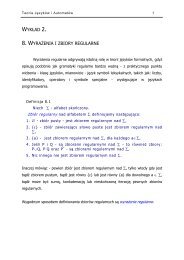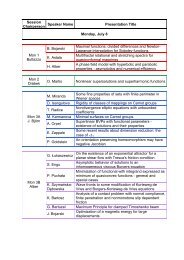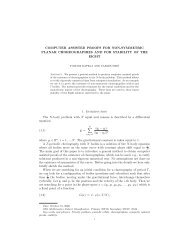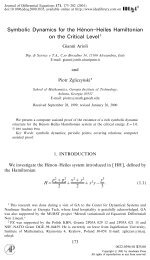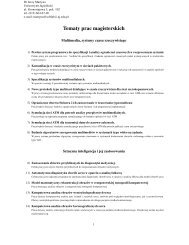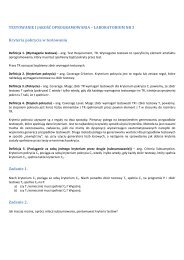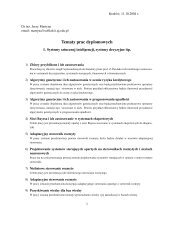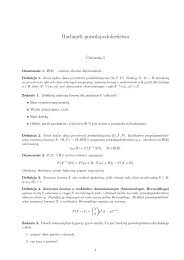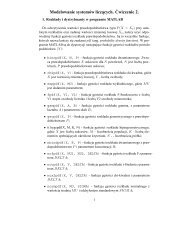A new strategy for finite element method adaptation
A new strategy for finite element method adaptation
A new strategy for finite element method adaptation
You also want an ePaper? Increase the reach of your titles
YUMPU automatically turns print PDFs into web optimized ePapers that Google loves.
CMM-2011 – Computer Methods in Mechanics9–12 May 2011, Warsaw, PolandA <strong>new</strong> <strong>strategy</strong> <strong>for</strong> <strong>finite</strong> <strong>element</strong> <strong>method</strong> <strong>adaptation</strong>Piotr OpiołaInstitute of Computer ScienceFaculty of Mathematics and Computer ScienceJagiellonian Universityul. prof. Stanisława Łojasiewicza 6, 30-348 Kraków, PolandAbstractThere are several adaptive approaches to <strong>finite</strong> <strong>element</strong> <strong>method</strong>, including the r-<strong>method</strong>, the p-<strong>method</strong> and the h-<strong>method</strong>. The adaptive<strong>method</strong>s are used to optimize the mesh and the approximation function by minimizing a monitor function. The monitor function usuallyconsists of an approximation error estimate and some chosen measures of the mesh quality, such as smoothness or orthogonality. Inthe paper, we present a <strong>new</strong> approach, in which the monitor function consists of an approximation error estimate, the number of meshpoints and a numerical error estimate. The optimization is per<strong>for</strong>med by adding and removing the mesh points, and by changing theapproximation order. The <strong>method</strong> has been tested on several boundary and initial problems, including the Laplace’s equation, the heatequation and the wave equation.Keywords: adaptive <strong>finite</strong> <strong>element</strong> <strong>method</strong>, partial differential equationsWe define a mesh as a <strong>finite</strong> set M = {x ⊂ Ω and1. Introductionmax x∈Ω (5) i} i=1...Na neighborhood function N : Ω → P(M). The neighborhoodThe <strong>finite</strong> <strong>element</strong> <strong>method</strong> is a powerful tool <strong>for</strong> solving partialdifferential equations, mainly appreciated <strong>for</strong> being general The domain is divided into <strong>element</strong>s. Two points x, y belong tofunction maps a point x ∈ Ω into a nonempty set of its neighbors.and flexible. However, the process of adjusting the <strong>method</strong> to the same <strong>element</strong> iff N (x) = N (y). Having a mesh (M, N ),a particular problem is usually difficult and exacting. To make we define the approximation ũ : Ω → R asthis process more convenient, an automatic mechanism is necessary.Such a mechanism is provided by adaptive <strong>finite</strong> <strong>element</strong><strong>method</strong>s, which have been developed <strong>for</strong> years [1, 2], still being‖x − x i‖w i(x) = 1 −, ∑x j ∈N (x)‖x − xj‖(6)improved.The novelty of our <strong>method</strong> is in the intuitive <strong>for</strong>mulation of∑the monitor function, flexibility of the approximation function,xand effective mesh generation algorithm <strong>for</strong> higher dimensions. ũ(x) = i ∈N (x)wi(x)ui + wi(x)ri(ui + qi · (x − xi))∑xSimilarly to e.g. [3], the monitor function consists of an approximationerror estimate and measures of the mesh quality. The(7)i ∈N (x) wi(x) + ,wi(x)ridifference is that orthogonality and smoothness as the mesh qualitymeasures are replaced by the number of mesh points and ai ∈ R, r i ≥ 0, u i ∈ R, q i ∈ R n ,where ror rnumerical error estimate. Such a <strong>for</strong>mulation helps in controllingthe <strong>method</strong> efficiency with two meaningful parameters: thei ∈ R, r i ≥ 0, u i ∈ R n , q i ∈ R n×n are the approximationparameters. The parameters, as well as the mesh points M,are sought to minimize the monitor function E, defined asexpected approximation error and the expected number of points.E = 1 2. Problem descriptionα Eε + 1 β EN + E δ, (8)We consider three first-order BVPs∇u(x) = f(x), <strong>for</strong> x ∈ Ω ⊂ R n , (1)whereE ε = max |ũ(x) − u(x)|,x∈Ω(9)divu(x) = f(x), <strong>for</strong> x ∈ Ω ⊂ R n , (2) E N = N, (10)∇ vu(x) = f(x), <strong>for</strong> x ∈ Ω ⊂ R n , (3)1Ewhere ∇ v is the directional derivative in the direction v. We seek δ = maxi≠j ‖x i − x . j‖ (11)a solution u : Ω → R <strong>for</strong> Eqn. (1) and (3), or u : Ω → R n <strong>for</strong>Eqn. (2), in the C 1 class. The boundary conditions are given byThe parameters α and β have the meanings of the expected errorand the expected number of mesh points respectively. Theu(x) = g(x), <strong>for</strong> x ∈ Γ ⊂ ∂Ω. (4) parameters provide a convenient way to control the balance betweenIf there is more than one solution <strong>for</strong> a given problem (1), (2) orprecision and efficiency of the <strong>method</strong>.(3), we want to obtain any of the solutions. If there is no solution,we solve the optimization problemE ε ≈ max |ũ(xi; M) − ũ(xi; M\{xi})|x i ∈M(12)
CMM-2011 – Computer Methods in MechanicsThe numerical results, including the error estimate, the realerror, the number of iterations and the number of mesh points,are presented in Tables 1, 2 and 3. The <strong>method</strong> has been tested<strong>for</strong> various values of the expected approximation error α and theexpected number of mesh points β.References9–12 May 2011, Warsaw, Poland[1] E. Kita, “Error estimation and adaptive mesh refinement inboundary <strong>element</strong> <strong>method</strong>, an overview,” Engineering Analysiswith Boundary Elements, vol. 25, no. 7, 2001.[2] K. Segeth, “A review of some a posteriori error estimates <strong>for</strong>adaptive <strong>finite</strong> <strong>element</strong> <strong>method</strong>s,” Mathematics and Computersin Simulation, vol. 80, no. 8, pp. 1589–1600, 2010.[3] G. Bono and A. Awruch, “An adaptive mesh <strong>strategy</strong> <strong>for</strong> highcompressible flows based on nodal re-allocation,” Journal ofthe Brazilian Society of Mechanical Sciences and Engineering,vol. 30, no. 3, pp. 189–196, 2008.



